My personal introduction to yogurt involved a TV commercial featuring a wrinkled, older man wearing a traditional Russian ushanka fur hat out in the snow, eating a cup of creamy goodness the announcer said would help me live to 103, just like him.
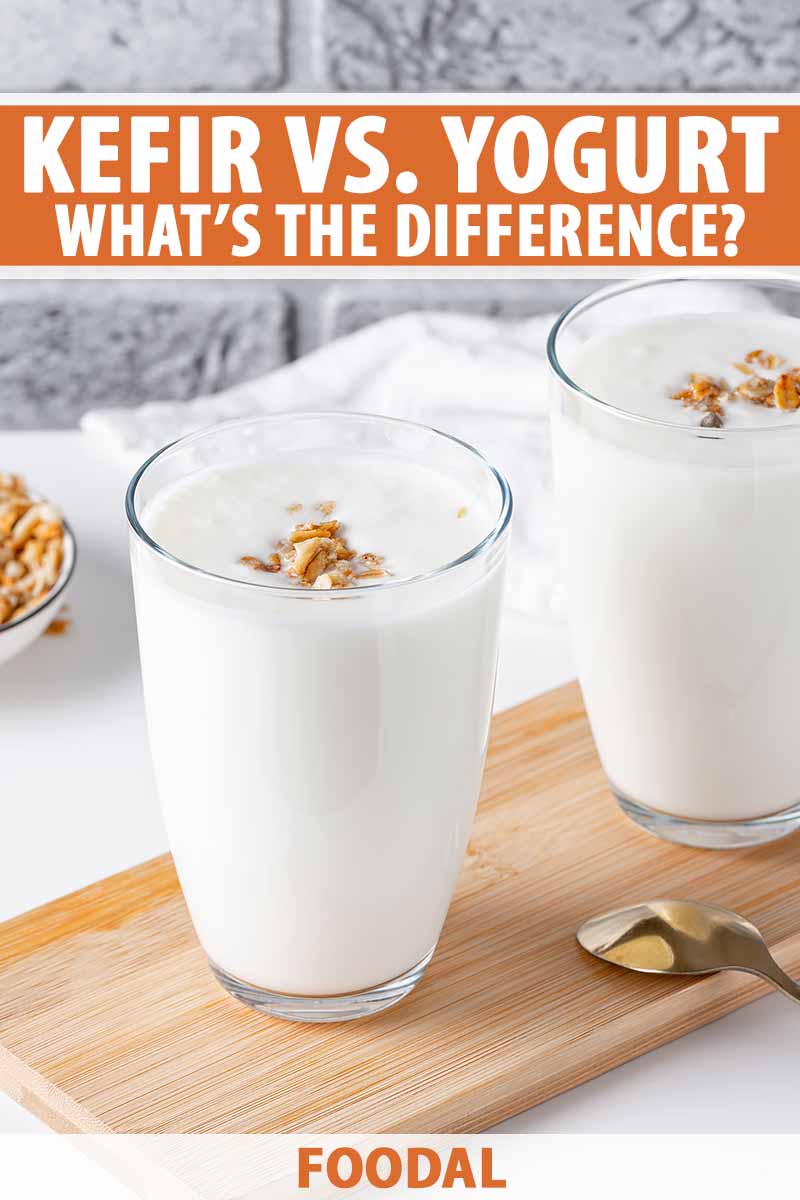
At the time, no one in my family ate it. And at the age of 10, I wasn’t worried about longevity.
Fast-forward to today, and yogurt and its fermented dairy cousin kefir, pronounced “kuh-feer,” are high on the list of probiotic wonders. Being on a dairy-free diet myself, I had never explored the possibilities of kefir, and thought it was time to educate myself, compare the two, and share what I learned with you.
Here’s what we’ll discuss:
What You’ll Learn
Here we go!
Kefir’s Early Beginnings
From the 1500s to the early 1900s, tribes in the Caucasus Mountains of czarist Russia were the sole trustees of what were known as the “grains of the prophet.”

Kefir grains resemble bits of cauliflower and consist of a symbiotic culture of lactic acid, probiotic bacteria, yeast, polysaccharides, and proteins. The acronym used to describe this type of culture is “SCOBY” – for a symbiotic culture of bacteria and yeast.
When mixed with milk, the SCOBY consumes milk sugar, or lactose. During the process, exopolysaccharides called keferins are excreted. The resulting beverage is acidic and creamy, filled with tiny gas bubbles.
Legend has it that the prophet Mohammed gave the people these “healing” grains, taught them how to preserve milk, and warned against sharing the secret with outsiders. Their probiotic properties likely contributed to the long life of many Caucasians.
The fermentation process was a simple one. The precious grains and milk from an animal, like a camel, cow, goat, sheep, or yak, were put into animal skin bags and hung in doorways. People passing through would move them about, facilitating the fermentation process.
As with a sourdough starter, the people retained the grains and added fresh milk for a continuous beverage supply.
In the early 20th century, the legend continues with an attempt by Russia’s medical society to obtain the grains for use in treating patients, followed by an alliance with a Moscow dairy.
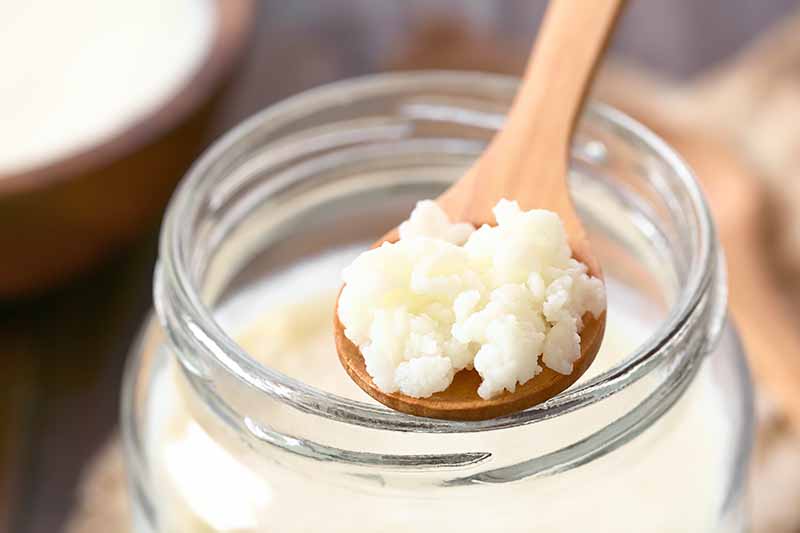
The dairymen’s ploy to obtain the grains by employing the wiles of a fair maiden allegedly led to a Caucasian prince’s refusal. After he ordered the kidnapping of the maiden, the Czar ordered her returned and demanded a nominal number of grains be given per the original request.
By the 1960s, the ancient fermented beverage had made its way across the world to the United States, as part of the burgeoning “health food” movement.
Today there are powdered kefir cultures available for easy home mixing with dairy, a plant-based alternative beverage, or water.
In addition to plain and flavored beverages, ready-made products for purchase include kefir butter and cheeses. There are also flavored water-based beverages that you might come across called “tibicos.”
Note that the average kefir product contains 0.48 percent alcohol, due to the fermentation process. This is similar to the amount that might be found in ripe fruit, or fruit juices.
In addition, note that there is a similar type of fermented dairy beverage called kumis, made from donkey or mare’s milk. Not produced from SCOBY grains, it originates with a liquid “starter culture” that results in a higher alcohol content.
Yogurt Is Born
Yogurt may date to ancient Roman times as noted by Pliny the Elder, a noted naturalist and philosopher whose writings mention a thickened, acidic milk.
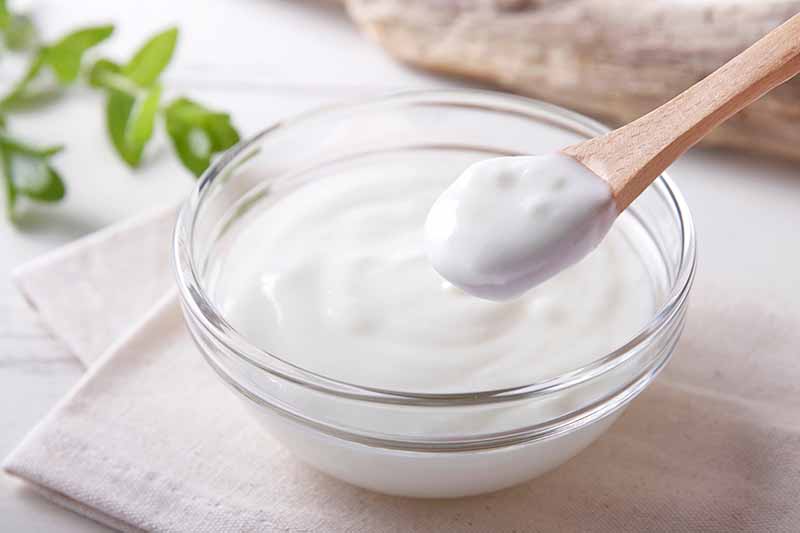
You could say modern-day yogurt was born on June 8, 1904, when Russian biologist Élie Metchnikoff gave a lecture entitled “Old Age,” in which he discussed gut bacteria and its role in the aging process.
Advising the washing of produce, he also recommended consuming fermented dairy products. He said Bulgarians who ate products containing what he dubbed “Bulgarian bacillus” lived longer than those who didn’t.
Yogurt is made by heating and cooling milk before adding the bacterial cultures that cause it to ferment. Unlike kefir, a fizzy beverage, it is a semi-soft food eaten with a spoon that is often sweetened with sugar or honey and/or fruit. Today’s products include drinkable and frozen options, as well as thick Greek-style yogurt, which has been strained.
Nutritional Components
Both of our subject dairy foodstuffs contain beneficial ingredients.
Per the USDA, a 100-milliliter serving of kefir made from cultured, grade A pasteurized, and homogenized cow’s milk contains:
- Protein – 3.33 grams
- Total Lipids (Fat) – 3.33 grams
- Total Sugar – 2.92 grams
- Calcium – 125 milligrams
- Vitamin A – 125 IU (37.5 micrograms)
- Cholesterol – 12 milligrams
And, per the USDA, a 100-gram serving of plain whole milk yogurt (or about 96.5 milliliters, so this is a close comparison in terms of volume) contains:
- Protein – 3.82 grams
- Total Lipids (Fat) – 4.48 grams
- Total Sugar – 4.09 grams
- Calcium – 127 milligrams
- Vitamin A – 48 micrograms
- Cholesterol – 14 milligrams
Comparing a liquid to a semi-soft product may seem a little like comparing apples to oranges, but the key takeaway here is that these are very similar in their nutritional makeup.
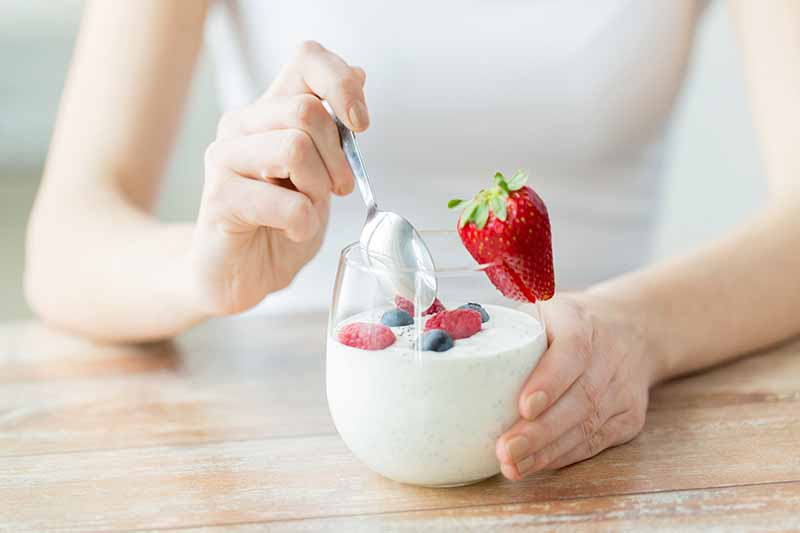
Low-fat or non-fat options are available for those who wish to limit their fat intake, and strained Greek yogurt offers more protein per serving than regular versions, since it is a more concentrated product.
Both dairy products contain healthy probiotics. Kefir includes over 300 microbial species, making it richer in probiotics than yogurt, which generally has four to six strains of beneficial bacteria.
And while studies show that these in fact may be beneficial to human health, especially for those suffering from conditions like antibiotic-induced diarrhea and IBS, determining the correct dosage or the best strains to consume poses a challenge. I can attest that too much of a good thing can have the opposite effect of the one desired!
If consuming fermented dairy products for the first time, try a small quantity and see how you feel.
Note that if you are lactose intolerant, you may be able to eat these products. Full-fat milk that has not been fermented contains 4.81 grams of lactose per 100-gram serving. The cultures “consume” a portion of the milk sugar as you can see from the sugar content listed for these products above, and fermented milk has a longer transit time through the digestive tract than regular milk.
Non-dairy options made with coconut, almond, and other types of milk, as well as water-based kefir, also offer probiotic benefits.
In the Kitchen
Plain milk kefir and yogurt are suitable one-to-one baking substitutes for each other. You can also use them in place of buttermilk and sour cream.

You can enjoy thicker kefir if you make your own and add cream during the fermentation process.
And you can have thinner yogurt if you dilute it with milk until it is pouring consistency.
You can enjoy making homemade kefir, homemade frozen yogurt, and dairy-free coconut yogurt with the handy recipes from Foodal.
Use your homemade creations in kefir-soaked spelt pizza dough, chocolate banana kefir smoothies, fluffy overnight pancakes, and fried kohlrabi with creamy cilantro sauce.
Did you know that you can also use both fermented dairy foods as starters for sourdough bread?
A typical recipe calls for 1 cup of nonfat milk, 3 tablespoons of plain yogurt, and 1 cup of flour, or 1 cup of kefir and 1 cup of flour.
And finally, both of our subject foods remain fresh in the fridge for up to two weeks.
Up Your Dairy Fermentation Game
I learned a lot, including how to say “kuh-feer” instead of “keff-er,” and I hope I’ve shared some information you can use.
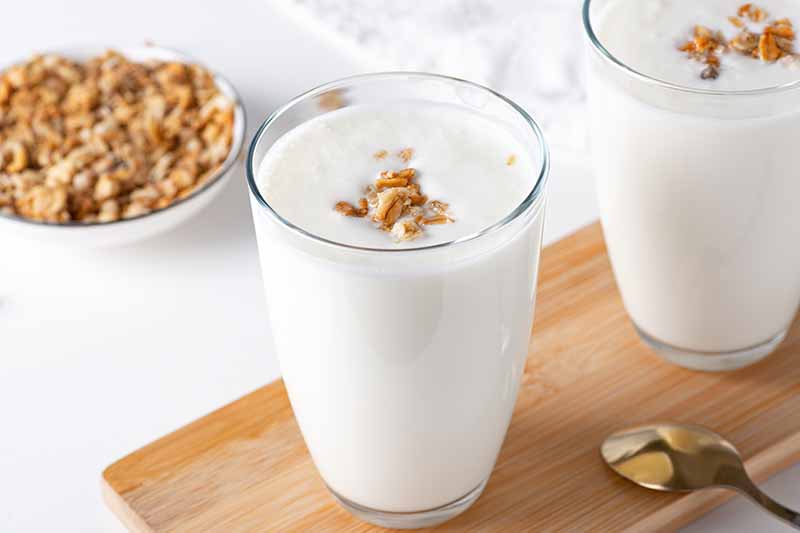
Fermented dairy products are one more resource to add to your ingredient supply. Whether you cultivate a greater appreciation for items you find on your grocer’s shelves or dive deep into making your own, knowledge is power in the kitchen.
How will probiotic dairy foods feature in your recipes?
If you’d like to contribute to this dairy-delicious conversation, please post your comments below.
And if you enjoyed learning about kefir and yogurt, we recommend continuing on your food knowledge journey by reading these guides next:
- Coconut Milk vs. Coconut Cream: What’s the Difference?
- Creme Fraiche and Sour Cream: What’s the Difference?
- Ice Cream vs. Gelato: What’s the Difference?
© Ask the Experts, LLC. ALL RIGHTS RESERVED. See our TOS for more details. Uncredited photos via Shutterstock.
About Nan Schiller
Nan Schiller is a writer from southeastern Pennsylvania. When she’s not in the garden, she’s in the kitchen preparing imaginative gluten- and dairy-free meals. With a background in business, writing, editing, and photography, Nan writes humorous and informative articles on gardening, food, parenting, and real estate topics. Having celiac disease has only served to inspire her to continue to explore creative ways to provide her family with nutritious locally-sourced food.




